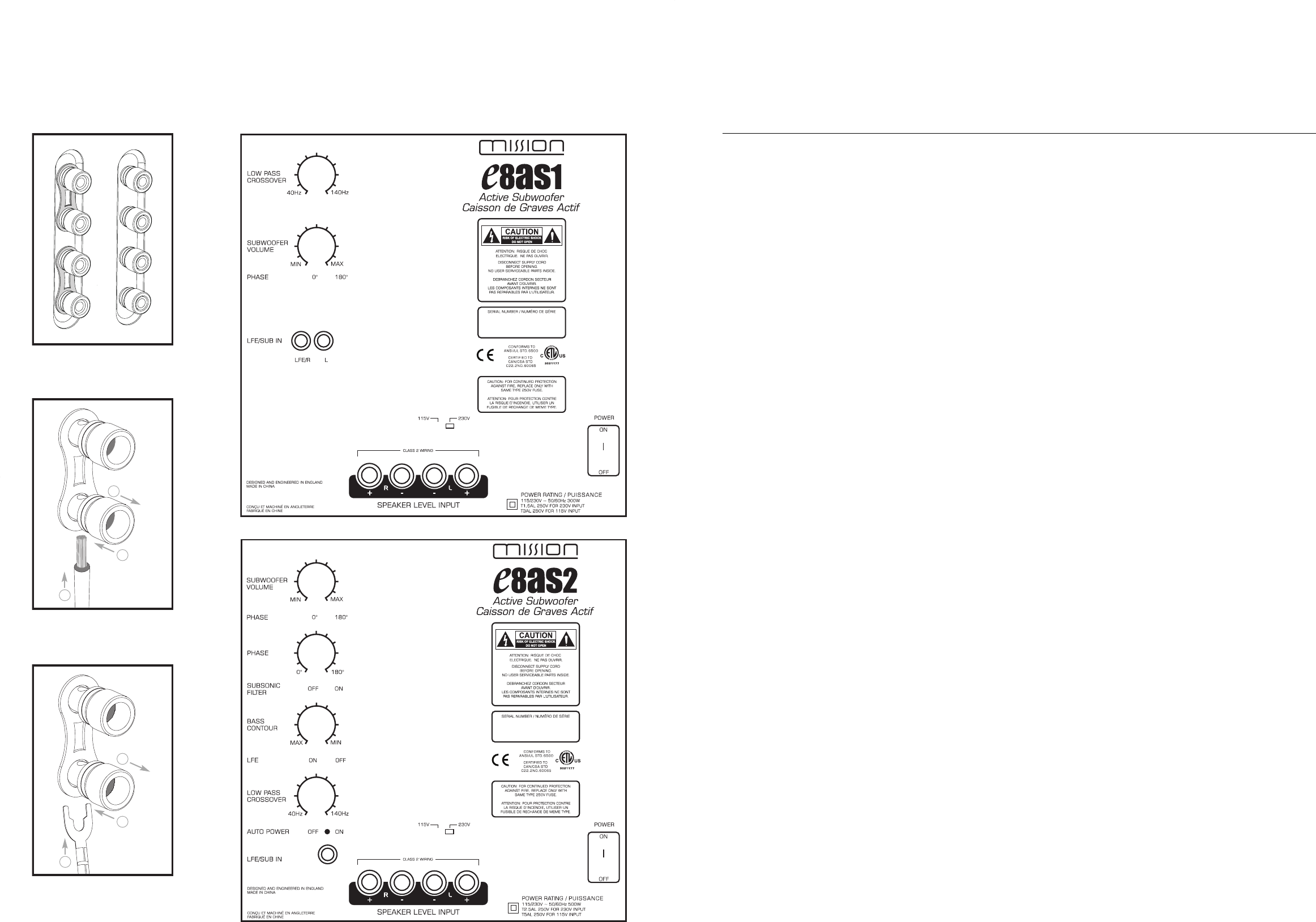
76
fig 1
fig 2
fig 3
1
2
3
1
2
3
or
System setup
Connecting
to
your
amplifier
The e series speakers are suitable for
bi-wiring and will benefit from careful
selection of partnering cables from your
amplifier. When bi-wiring, or bi-amping (fig 1),
remove the connecting links from between
the terminals at the rear of the speaker.
To connect using bare wires (fig 2), strip
10mm (1/2 inch) of insulation from each
cable. Loosen the terminal caps on the
speaker terminals to reveal the cross holes.
Twist the bared conductors together and
pass through the cross hole in the speaker
terminal, securing by screwing down the
terminal cap.
To connect using spade terminals (fig 3),
loosen the terminal caps on the speaker
terminals enough to locate the spades.
Tighten the terminal caps onto the spades
so that they are held securely.
Connect the positive speaker outlets on the
rear of your amplifier to the positive (red)
terminals on the rear of the speakers.
Similarly connect the negative speaker
outputs to the negative (black) terminals on
the speakers. Note that speaker cables
usually identify the positive conductor by
marking it with a stripe or raised ridge or
coloured band.
e8
as1/
e8
as2
To connect a stereo hi-fi amplifier it is
recommended that you connect the speaker
outputs of your amplifier to the speaker level
inputs of the subwoofer in parallel to the
connections made to your speakers.
To connect an AV multi-channel amplifier it
is recommended that you connect the LFE
line level input on the subwoofer to the
subwoofer output on your amplifier using an
RCA phono lead (not supplied).
Power
—
Set the subwoofer’s ON/OFF switch
to "Off." Then plug the power cord into an
AC outlet. You can turn the power on and off
manually using the switch, or you can leave
the mains power turned on and set the Auto
Power switch to "On," which will turn the
subwoofer on automatically when a signal
is detected at one of the inputs and off after
a period of inactivity.
AV
setup
In a multi-channel system it is
recommended that you use the bass
management facilities on your AV amplifier.
As the subwoofer is best employed to
reproduce bass, all low frequency
information should be directed to the
subwoofer enabling the main speakers to
reproduce upper bass, midrange and treble
with optimum clarity.
If you are using the bass management of an
AV amplifier, set all speakers to SMALL in
your amplifier's speaker configuration and
set SUBWOOFER to ON. Where the crossover
frequency can be chosen set it to 80Hz.
Alternatively choose the preset configuration
for THX.
Set the Low Pass Crossover Frequency
control on the subwoofer to 140Hz (on the
e8as2 set the LFE switch to ON). Adjust the
volume control to its mid position.
Use the distance parameters in your AV
amplifier speaker setup to set the distance
from each set of speakers to your listening
position.
Use the channel level adjustment in your AV
amplifier speaker setup to set the individual
output from each speaker. If you have a
sound level meter adjust the individual level
of each channel for a reading of 75dB at the
listening position. If you do not have access
to a sound level meter, set the channel
levels so that they sound equally loud at the
listening position.
Stereo
setup
In a hi-fi system without bass management
you must adjust the LOW PASS CROSSOVER
control on the subwoofer in conjunction with
the SUBWOOFER VOLUME control to achieve
a blend to your main speakers. The e8as1
and e8as2 subwoofers can be used with
the e82 and e83 floorstanding speakers in a
hi-fi system. (Note that the e80 is not
suitable for use in a hi-fi system without
bass management).
For the e82 speakers, start by setting the
LOW PASS CROSSOVER control to midway
and adjust the SUBWOOFER volume level to
provide a natural level of bass support
when playing music discs. For the e83
speakers, start by setting the LOW PASS
CROSSOVER control to between the 40Hz
and the midway position.
Adjusting
the
controls
Once you have completed the settings you
should prepare to fine-tune the subwoofer
controls. Choose a multi-channel disc with
natural bass qualities - a music disc is best.
Adjust the control on the subwoofer's rear
panel marked PHASE to tune the blend
between the subwoofer and speakers.
Depending on your room acoustics the
sound will be fuller and more coherent with
the switch in the 0° or 180° position. Use
your judgement to set the switch to the best
sounding position.
On the e8as2 you also have fine control
over phase. Use the variable PHASE control
to achieve the fullest and clearest bass
response. In conjunction with the PHASE
switch, the phase can be varied over 180°.
Adjust the SUBWOOFER VOLUME control to
give bass output that is in balance with your
main speakers. Initially you may prefer the
subwoofer output at a relatively high level,
but this can become tiring, with an over-
emphasis on bass on extended listening.
Turn the volume down by degrees until the
subwoofer is not heard individually but
rather as an extension to the main
speakers.
On the e8as2 you can fine tune the bass
performance to suit your room. If the bass is
boomy, or appears uncontrolled at very low
frequencies, switch the SUBSONIC FILTER to
ON. Adjust the BASS CONTOUR to control
output at the very low frequencies.


















